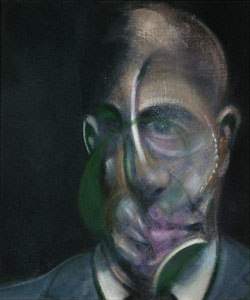Portrait des Michel Leiris, 1976 Paris, Musée National d'Art Moderne, Centre de création industrielle Centre Georges Pompidou © The Estate of Francis Bacon / VBK, Wien, 2003 Francis Bacon und die Bildtradition Click for English text Das Kunsthistorische Museum veranstaltet die erste grosse Einzelausstellung in Österreich, die dem 1909 in Dublin geborenen und bis zu seinem Tod 1992 in London lebenden Künstler Francis Bacon gewidmet ist. Die Ausstellung ist keine Retrospektive, sondern stellt das Werk Bacons erstmalig in der Bacon-Forschung in ein Netzwerk von Beziehungen zu den alten Meistern bis hin zu Künstlern des 20. Jahrhunderts. Die Ausstellung umfasst rund 40 Werke von Francis Bacon und ebensoviele Werke anderer Künstler, unter ihnen Velázquez, Rembrandt, Tizian, Ingres, Degas, Schiele, Giacometti und Picasso sowie Filme von Eisenstein und Buñuel. Weiter werden erstmalig Fotovorlagen und Skizzen des Künstlers ausgestellt, die er in seinem Atelier aufbewahrte und als Inspirationsquellen für seine Ölbilder dienten. Dieses Material ist seit 1998 im Besitz der Hugh Lane Municipal Gallery of Modern Art in Dublin, wo Bacons Atelier nach seinem Tod wieder aufgebaut wurde. Aus dem Fundus der Studiovorlagen - Abbildungen aus Kunstbüchern und Magazinen, Photographien und frühen Zeichnungen - hat die Kuratorin 71 Exemplare ausgesucht, die den Zusammenhang zwischen Bacon und seinen Vorbildern veranschaulichen. Die Ausstellung ist in folgende Themenkreise gegliedert: die Tradition des Papstportraits, Bacons Papstbilder, das Motiv "der Schrei" bei Bacon, das Motiv des Käfigs, Bacon und der Surrealismus, Bacon und Van Gogh, der Bildtypus des Triptychons, Portrait und Selbstportrait, die Repräsentation des Körpers im Zusammenhang mit Ingres und Velázquez, das Spiegelmotiv in Bacons Werk und andere. Unter den Hauptwerken der Ausstellung befindet sich zum Beispiel das Triptychon "Three Studies for a Crucifixion" von 1962 aus dem New Yorker Guggenheim Museum, das schon seit vielen Jahren nicht mehr ausserhalb der USA gezeigt wurde. Weiter werden Werke aus amerikanischen Privatsammlungen präsentiert, die teilweise zum ersten Mal in Europa zu sehen sind. Neben sechs Versionen des schreienden Papstes sind unter anderem Variationen über ein zerstörtes Selbstportrait von Van Gogh zu sehen. Begleitend zur Ausstellung werden Vorträge von internationalen Bacon-Experten stattfinden. Ausserdem erscheint ein Katalog zur Ausstellung, der von Wilfried Seipel und Barbara Steffen gemeinsam herausgegeben wird. Gastkuratorin: Mag. Barbara Steffen Ausstellungsdauer: 15.10.2003 - 18.1.2004 Oeffnungszeiten: Di-So 10 - 18 Uhr, Do 10 - 21 Uhr Kunsthistorisches Museum Maria Theresien-Platz A-1010 Wien Telefon +43 1 525 24-0 Fax +43 1 525 24-503 E-Mail: info@khm.at www.khm.at Francis Bacon and the tradition of art The Kunsthistorisches Museum in Vienna will host the first solo exhibition in Austria, dedicated to the artist Francis Bacon, who was born in Dublin in 1909 and lived in London until his death in 1992. This exhibition is not a retrospective, but rather locates for the first time the network of relationships and influences spanning from the Old Masters to artists of the 20th century, which were crucial to Bacon's artistic development. The exhibition will include some 40 works by Francis Bacon, as well as about 40 works by other artists such as Velázquez, Rembrandt, Titian, Ingres, Degas, Schiele, Giacometti and Picasso, as well as films directed by Eisenstein and Buñuel. In addition, rarely exhibited preparatory photographs and sketches by Bacon, which he kept in his studio and used as inspiration for his oil paintings, will be shown. Since 1998, this material has been in the collection of the Hugh Lane Municipal Art Gallery in Dublin, where Bacon's studio was re-erected inside the museum after his death. From Bacon's collected studio material - among which are, for example, illustrations from art-books and magazines, photographs and early drawings - the curator of the exhibition has selected 71 items that document the interrelation between Bacon and earlier artists he admired. The exhibition consists of the following sections: the tradition of papal portraits, Bacon's papal portraits, the motif of the scream, the motif of the cage, Bacon and Surrealism, Bacon and van Gogh, Bacon's use of the triptych, portrait and self-portrait, the representation of the body in relation to Ingres and Velázquez, the motif of the mirror, and several other subjects. "Studies for a Crucifixion" from 1962, from the collection of the Solomon R. Guggenheim Museum, is one of the highlights in this exhibition. This tripytch has not been seen outside the US for several years. In addition, the exhibition will include works lent by American private collectors, some of which have never been exhibited before in Europe. There will be six versions of the screaming pope and two variations on a destroyed self-portrait by Van Gogh. Among the works by other artists are Titian's Portrait of "Cardinal Philipp Archinto" (c. 1560) from the Philadelphia Museum of Art, his Pope "Paul III" (1546) from the collection of the Kunsthistorisches Museum and Jean-Dominique Ingres' "Oedipus and the Sphinx" (1826-27) from the National Gallery in London, which was a direct model for Bacon's version of "Oedipus and the Sphinx". A pastel by Edgar Degas will illustrate why Bacon was so much impressed by the artist's technique. The exhibition will offer to Bacon scholars and visitors the comparison of drawings by Picasso of the theme of the bathers from the late 1920's with Bacon's Surrealist drawings from the early 1930's, the onset of his artistic career. Picasso's "Seated Woman" (1939) from the Berggruen Collection in Berlin is another important work included in the exhibition. The films "Battleship Potemkin" by Sergej Eisenstein, and the "Andalusian Dog" by Luis Buñuel/Salvador Dali will also be presented in the exhibition. Bacon was inspired by these films and used individual scenes and film stills for thematic development of his motifs in his paintings. A series of lectures by internationally-renowned experts on Francis Bacon will be organised. A catalogue edited by Wilfried Seipel and Barbara Steffen will accompany the exhibition. October 15, 2003 - January 18, 2004 |
|
